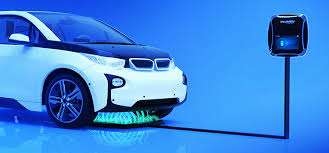According to a recent report from Bloomberg Green, the global wireless charging market for electric vehicles (EVs) is projected to reach $234 million by 2024, highlighting a significant shift in how cities and consumers are approaching EV adoption. In this article, we’ll explore how this cutting-edge technology is reshaping urban environments, the benefits it brings, and what it means for the future of transportation.
Understanding Wireless EV Charging and Its Benefits
What is Wireless EV Charging?
Wireless EV charging, also known as inductive charging, allows electric vehicles to charge without the need for physical connectors. This technology uses electromagnetic fields to transfer energy between a charging pad on the ground and a receiver on the vehicle. According to TechCrunch, companies like WiTricity and Plugless Power are leading the charge in developing this innovative technology.
Key Benefits of Wireless Charging
- Convenience: No more fumbling with cables. Just park and charge.
- Reduced Wear and Tear: Eliminates the physical connectors, reducing maintenance needs.
- Enhanced Urban Aesthetics: No more cluttered streets with charging cables.
- Increased Accessibility: Easier for the elderly and disabled to charge vehicles.
Adoption in Urban Areas
Cities like Oslo and Los Angeles are pioneering the adoption of wireless charging infrastructure. As reported by Reuters Mobility, Oslo’s taxis will soon feature wireless charging capabilities, cutting down emissions and showcasing a model for urban sustainability.
Wireless Charging Technology: How It Works
Inductive Charging Explained
Inductive charging works through a process called electromagnetic induction. Here’s a simplified breakdown:
- Charging Pad Installation: A charging pad is installed on the ground, which is connected to an electric power source.
- Vehicle Receiver: The EV is equipped with a receiver coil.
- Energy Transfer: When the vehicle is parked over the pad, energy is transferred wirelessly through the electromagnetic field.
- Charging Process: The vehicle’s battery is charged without any cable connections.
Efficiency and Challenges
While the technology is promising, it faces challenges such as energy efficiency and installation costs. According to InsideEVs, current systems have an efficiency rate of 85-90%, slightly lower than traditional plug-in methods. However, ongoing advancements are expected to close this gap.
Practical Tips for Adopting Wireless Charging
How to Charge: Step-by-Step Guide
- Find a Compatible Charging Spot: Use apps like PlugShare to locate wireless charging stations.
- Position Your Vehicle: Align your EV over the charging pad.
- Initiate Charging: Typically, charging begins automatically, but some systems may require an app or dashboard confirmation.
- Monitor Charge Level: Use your vehicle’s app to monitor charging progress.
Where to Buy Wireless Charging Systems
For those interested in home installations, brands like WiTricity and Plugless Power offer solutions compatible with popular EV models, including Tesla, Hyundai, and Nissan. Consult with a certified installer to ensure compatibility and safe installation.
What to Compare
When considering wireless charging, compare:
- Efficiency Rates: Look for systems with higher efficiency to reduce energy loss.
- Compatibility: Ensure the system is compatible with your specific EV model.
- Installation Costs: Evaluate the total cost, including equipment and installation fees.
The Future of Urban Mobility with Wireless Charging
Transforming Public Transportation
Wireless charging is not just for personal vehicles. Public transportation systems, such as buses and trams, are beginning to incorporate this technology. According to CleanTechnica, cities like London are testing wireless charging for buses, which could drastically reduce downtime and improve efficiency.
Impact on Urban Planning
As cities integrate wireless charging into public infrastructure, urban planning will focus more on sustainability and reducing carbon footprints. The seamless integration of charging pads in parking lots and roads could lead to smarter, cleaner cities.
A Look Ahead
Looking forward, the integration of wireless charging with autonomous vehicles could redefine urban mobility. As highlighted by MIT Technology Review, the combination of these technologies could lead to a future where vehicles charge themselves while on the move, further enhancing convenience and efficiency.
Conclusion
Wireless EV charging is set to revolutionize how we think about urban mobility and sustainability. By offering convenience, reducing street clutter, and enhancing accessibility, this technology presents a compelling case for cities aiming to embrace greener transportation solutions. As we move into 2024, consider how wireless charging could fit into your life or city planning. Are you ready to embrace the future of urban mobility? Let us know your thoughts in the comments below!
In the coming years, the integration of wireless charging technology will not only change how we charge our vehicles but also how cities design their infrastructure. It’s an exciting time for urban planners, EV enthusiasts, and anyone interested in sustainable living. Stay tuned as we continue to follow this transformative journey.

